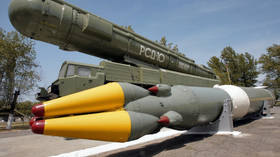US unleashed ballistic missile arms race, and here's where we are 20 years on
Twenty years ago this week, the US announced that it would withdraw from the Anti-Ballistic Missile Treaty signed by Moscow and Washington back in 1972. What changes has this brought about since?
On December 13, 2001, then US president George W. Bush gave formal notice to Russia about the US decision to withdraw from the ABM Treaty. In accordance with Article 15 of the treaty, the withdrawal came into effect six months later, on June 13, 2002.
Russia immediately called this decision a mistake and insisted on keeping the crucial bilateral treaty intact, citing its international importance and dubbing it “a cornerstone of strategic stability and security.”
The US, however, had stated its intention to withdraw from the treaty a number of times – saying that it was outdated – and to develop its own national anti-ballistic missile defense system.
That said, all the experts worth their salt – both in Russia and in the West – admit that no missile defense system would be able to protect a territory of the country facing the first large-scale nuclear attack.
Could the treaty be preserved?
Signing the ABM Treaty and the 1974 Protocol, the USSR and the US sought to protect their strategic nuclear bases and command centers to guarantee a symmetrical response in case of an aggression.
Naturally, treaties are only signed and observed when there is parity. No state would enter into a treaty, let alone fulfill its obligations under it, with a political and military equivalent of a corpse – and I would argue that Russia was in a sorry state in the late ’90s.
Still, many experts agree that back then, in the early 2000s, there was room for compromise. The US wanted to get rid of the limitations, but was willing to offer something in return. Russia, however, was adamant about keeping the treaty the way it was.
How many arguments ensued over the fact that the missile defense systems should not be “directed at anyone”? Missile defense systems are not guns or cannons, they are not actually aimed anywhere. They are meant for the all-round defense of a certain site where key facilities are located.
How many diplomats tried and failed to get the US to “guarantee their missile defense system would not be used” against Russia? Let’s look at an oversimplified example and try to understand what kind of guarantees we could be talking about.
First off, the US would never provide any guarantees to anyone when it comes to missile defense. Imagine there is a battle in European airspace involving NATO and some Middle Eastern/Central Asian/Far Eastern countries that possess missile technology and other relevant types of weapons (when that might happen is another issue entirely). If Russia is not a party to the conflict, what guarantees would we need?
There is no way that a bunch of unrelated Russian missiles would suddenly appear amid this hypothetical conflict between the East and the West unfolding in European airspace, and that the US/European missile defense systems wouldn’t shoot them down because of existing binding obligations.
If we say that Russia is, in fact, part of this hypothetical conflict, then what guarantees could there be? Hardly any. Considering all of the above, what chance was there to achieve any progress in the ABM Treaty talks?
Take a closer look at any conference, meeting or talks on armaments and weapons – who are the specialists participating in them? They are political scientists, economists, legal experts, psychologists, and so on. It seems as if our universities added missile defense to their majors, offering courses in radars, electromagnetic field theory, super-high frequency and radio transmission technology, automatic guidance and operation theory, receivers and radio wave transmission. Alternatively, everyone believes that those who negotiate over missile defense-related issues have no need for any theoretical or practical knowledge in this field. They are good negotiators, and that’s it. One could only hope that the next round of talks with the US will involve highly qualified experts.
It’s doubtful, though, that lessons have been learned. Currently, there is a debate about the US and NATO providing Russia with written guarantees that Washington and Brussels would curb the alliance’s expansion to the east.
This demand might meet the same fate as the 1972 ABM Treaty. A different scenario would only be possible if Russia had a larger GDP and a better Navy than the US, while the Russian Aerospace Forces and Army were equipped with such cutting-edge hardware and weapons that they would turn both the Pentagon and Mons green with envy. Otherwise, no guarantees, especially in written form, are likely to be forthcoming.
US bases in Poland and Romania
Soon after withdrawing from the 1972 ABM Treaty, the US started installing the Aegis Ashore system in the northern part of Poland, at the commissioned missile defense facility in Redzikowo.
While the missile defense base is still under construction and is expected to begin operations in 2022, the AN/SPY-1D(V) radar and Fire Control System (FCS) at Redzikowo were tested in March.
The purpose of the American missile defense base in Poland is to detect, escort and intercept ballistic missiles. The US believes that despite its location near the Russian border it wouldn’t jeopardize Russia’s strategic potential.
The missile defense site that is in the process of being developed in Poland is a land-based component fitted with SM-3 missiles and their modifications. Aegis Ashore employs the equipment commonly used by the Navy in land-based facilities. The elements that are specific to warships are removed from Aegis Ashore, which has been modified for a land-based site. A steel structure, four stories tall and weighing about 900 tons, replicates that of the Ticonderoga guided-missile cruisers. The Aegis Ashore equipment includes SPY-1 radars and Mark 41 vertical launching systems for SM-3 missiles.
Washington has repeatedly stated that this site will help defend Western Europe from Iranian missiles.
In 2016, the first European land-based Aegis Ashore missile defense complex was opened in Romania’s Deveselu.
The facilities in Romania and Poland along with four US Navy destroyers, permanently stationed in Spain, are the main components of the European phased adaptive missile defense system.
The Aegis Ashore system can guarantee, to some extent, defense against missile attacks that are not massive. No defense system can handle a purely hypothetical situation of a large-scale nuclear missile exchange between the United States and Russia. And there are no effective defense capabilities against Russia’s Avangard hypersonic glide vehicles at all. They simply don’t exist at this point.
The development of the Aegis Ashore complex in Poland worries Russia. Here is the problem. The Mark 41 launching system can be quickly adjusted, and the SM-3 would be replaced with Tomahawk land attack cruise missiles
What is Russia supposed to do in this situation, when such a transformation of the land-based Aegis system in Poland could pose a very real threat to its national security?
Poland and Romania must realize that if there is a conflict between Russia and NATO, the missile defense bases in Redzikowo and Deveselu will be the first targets of a nuclear attack.
A short initial phase of an armed conflict will probably only involve conventional weapons, but the site in northern Poland, which will obviously top the list of potential targets, can be attacked with Kh-101 air-launched cruise missiles and Kalibr-NK or Kalibr-PL sea-based missile systems. The Polish Aegis Ashore facility will also be a priority target for Russia’s Iskander-M short-range ballistic missile systems.
What are Russia’s benefits?
Under the 1972 ABM Treaty, each party couldn’t have more than two missile defense systems (around the capital and near the site of intercontinental ballistic missile launchers). No more than 100 stationary missile defense launch systems could be positioned within the radius of 150km. Later, in July 1974, the countries signed a protocol that further restrained deployment of strategic defensive armaments. The protocol limited each side to one site only. The Soviet Union chose to maintain its ABM defense of Moscow, and the United States decided to keep defense of its ICBM emplacements near its Vandenberg Base.
The A-135, Russia’s only strategic ABM defense system deployed around Moscow, includes a command center fitted with computing facilities and system controls; a PRS-1 short-range missile interceptor; the Don-2N large battle-management phased array radar with 360° coverage; a nuclear warhead for the missiles; and launching silos. The A-135 system is fully automated.
The A-135 system is obviously exceptional, but it also has two major shortcomings. First, this is a stationary system. The Don-2N radar resembles an Egyptian pyramid with multiple underground levels and launching silos.
Secondly, the PRS-1 high-speed interceptor can only use a nuclear warhead, which limits the A-135 combat capabilities significantly. A nuclear blast directly over the capital would be a disaster, so nobody would use the A-135 system to intercept intercontinental ballistic missiles in close proximity to Moscow.
That’s why the S-550 and Nudol, the new systems that are under development and could potentially become strategic missile defense components, are designed with mobile and non-nuclear options. This would make it possible for the systems to be deployed to any battleground and provide efficient strategic missile defense for the forces and key infrastructure.
Very soon, Russia will be able to deploy a missile defense system to any potential conflict zone. The new S-550 and Nudol systems may serve as a deterrence factor or an effective combat weapon.
The statements, views and opinions expressed in this column are solely those of the author and do not necessarily represent those of RT.

















